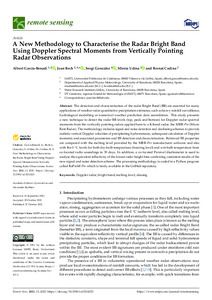Por favor, use este identificador para citar o enlazar este ítem:
http://hdl.handle.net/20.500.11765/13117
A new methodology to characterise the radar bright band using doppler spectral moments from vertically pointing radar observations
| Título : | A new methodology to characterise the radar bright band using doppler spectral moments from vertically pointing radar observations |
| Autor : | García-Benadi, Albert; Bech, Joan; González Herrero, Sergi



|
| Palabras clave : | Doppler radar; Bright band; Melting level; Aliasing |
| Fecha de publicación : | 2021 |
| Editor: | MDPI |
| Citación : | Remote Sensing. 2021, 13(21), 4323 |
| Versión del editor: | https://doi.org/10.3390/rs13214323 |
| Resumen : | The detection and characterisation of the radar Bright Band (BB) are essential for many applications of weather radar quantitative precipitation estimates, such as heavy rainfall surveillance, hydrological modelling or numerical weather prediction data assimilation. This study presents a new technique to detect the radar BB levels (top, peak and bottom) for Doppler radar spectral moments from the vertically pointing radars applied here to a K-band radar, the MRR-Pro (Micro Rain Radar). The methodology includes signal and noise detection and dealiasing schemes to provide realistic vertical Doppler velocities of precipitating hydrometeors, subsequent calculation of Doppler moments and associated parameters and BB detection and characterisation. Retrieved BB properties are compared with the melting level provided by the MRR-Pro manufacturer software and also with the 0 °C levels for both dry-bulb temperature (freezing level) and wet-bulb temperature from co-located radio soundings in 39 days. In addition, a co-located Parsivel disdrometer is used to analyse the equivalent reflectivity of the lowest radar height bins confirming consistent results of the new signal and noise detection scheme. The processing methodology is coded in a Python program called RaProM-Pro which is freely available in the GitHub repository. |
| Patrocinador: | This research was partly funded by the project “Analysis of Precipitation Processes in the Eastern Ebro Subbasin” (WISE-PreP, RTI2018-098693-B-C32, MINECO/FEDER) and theWater Research Institute (IdRA) of the University of Barcelona. |
| URI : | http://hdl.handle.net/20.500.11765/13117 |
| ISSN : | 2072-4292 |
| Colecciones: | Artículos científicos 2019-2022 |
Ficheros en este ítem:
| Fichero | Descripción | Tamaño | Formato | ||
|---|---|---|---|---|---|
| remotesensing-13-0432... | 7,42 MB | Adobe PDF |  Visualizar/Abrir |
Los ítems de Arcimis están protegidos por una Licencia Creative Commons, salvo que se indique lo contrario.





